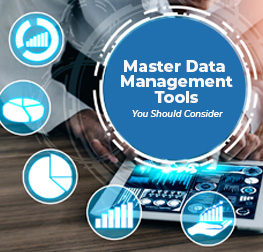Master Data Management - An Ultimate Guide
Every enterprise generates lots of data related to its products, services, processes, operations, applications, customers, enterprise data, performance metrics, etc. This data keeps on increasing and it is important to handle this data efficiently. Through the master data management guide, we will explain to you how MDM paves the path to success for your business.
The organization needs to implement different applications for managing data like Enterprise Resource Planning (ERP), Business Intelligence (BI), Customer Relationship Management (CRM), Marketing automation, etc. This is where Master Data Management comes to play.
Master Data Management (MDM) allows for data synchronization. It acts as a single source of data across multiple systems for managing the ever-increasing volumes of data.
- What is Master Data Management (MDM)?
- List of Key Components of the Master Data Management Framework
- Operation of A Good Master Data Management
- Why Should Businesses Consider Master Data Management?
- Advanced Capabilities of Master Data Management
- 12 Business Benefits of Master Data Management Solution
- Top 6 Master Data Management Strategies to Follow In 2023
- Leverage Successful MDM Implementation with This Master Data Management Guide
What is Master Data Management (MDM)?
Every organization implements a business-led program for the Master Data Management (MDM) that enables ensuring data accuracy, and consistency while sharing the data. MDM helps in creating a single master record for every person, asset, and place involved in the business across the data systems and sources available internally as well as externally.
Master Data Management (MDM) System enables the organization to handle the data from different departments like R&D, manufacturing, operations, information technology, sales and marketing, regulatory affairs, costing and finances, etc.
It involves the people, technology, tools, systems, and processes used for establishing a single unified source of true details. Master Data Management (MDM) System serves as a single trusted source for managing and sharing the data across the organization.
It enables keeping the data free from inconsistency, duplication, redundancy, and errors. It allows for sharing accurate and real-time data helping the stakeholders in making smarter business decisions.
MDM relies on the principles of data governance for the automation of data management and sharing. It leverages different techniques for data integration, enrichment, and quality for creating master records.
If you are new to Master Data Management frameworks, then How To Succeed Master Data Management (MDM) – A Beginner’s Guide helps you delve into the exceptional abilities of master data management.
List of Key Components of the Master Data Management Framework
To manage, optimize, and transform the data of an organization, every Master Data Management (MDM) System must have a defined framework. However, the framework of an Master Data Management (MDM) System may vary depending upon the business requirements. In this master data management guide, we have provided a list of common components which are essential to delivering efficient outcomes.
Discovery to Identify Challenges
The discovery phase is before initiating any tools and technology investment. The phase will scan all of your business landscape and identify all the scopes and challenges. This will help you to set and prioritize your steps.
Connecting Disparate Data Sources
Data organization from all data sources of an organization and forming a centralized data repository is essential. This will help an organization to have a consolidated view of all data.
Preparing & Cleaning Data
Profiling data for errors and data cleansing must be done according to the standards. So that data reliability and data accuracy will be maintained on a consistent basis.
Data Matching & Removing Data Duplicates
Data matching should be done if a third-party data source is connected with the organization’s database. By doing so, data duplicates will be easily identified and removed.
Data Merging
After removing data duplicates from the centralized data repository, data should merge or be linked to create accurate data reports and to deliver a consolidated view to every user of an organization.
Building Data Relevance & Connectivity
To provide a true 360-degree view of the data, Master Data Management (MDM) System needs to build relevant and connected data by relating all the data points which include the information gathered from marketers, sales team, production team, and so.
Delivery of MDM source with Security
The ultimate goal of an MDM system is to safeguard the master data of an organization from unauthorized access. So, MDM should define a security policy to ensure data reliability while transforming or delivering.
To explore more advanced features of the Master data management platform, check out Essential Features of a Robust Master Data Management (MDM) Solution. Ensure integrating these features in your bespoke digital solution to leverage the maximum return on investment on MDM.
Operation of A Good Master Data Management
Without proper MDM plans project abandonment may happen. However, having a good MDM plan will always ensure your business’s success. In this master data management guide, we have portrayed certain notable aspects entailed by a good MDM. Take a look.
- Apart from just playing a handy role in the effective management of data, having a good MDM will always solve all the issues involved in data, data quality, team collaboration, and so in real-time.
- Good MDM follows and complies with all the standards & regulations on data quality. Also, it makes sure the data is complete, accurate, consistent, and duplicate-free before turning them into ‘master data’.
- MDM deals only with the data which are directly tied to or have an impact on the organization/business outcomes.
- It delivers a 360-degree view of the KPIs and data that support business objectives.
- A good Master Data Management (MDM) System ensures the data cleaning and consistency operations are carried out for a long time instead of focusing on the short-term.
- Error occurrences due to manual entry are reduced significantly. Also, data silos are eliminated by the MDM system to make sure all data remains quality and consistent.
Why Should Businesses Consider Master Data Management?
As the business grows, the products and services provided also grow generating a tremendous amount of data. The organization needs to handle the data from several sources and related to multiple divisions and departments within it.
As the data increases, there are more chances of data silos, data duplication, incomplete data, conflicting data, etc. that might affect the data quality.
As the business scales, the complexities involved in it also increase. The increase in the volume of data leads to an increase in the variety and veracity of critical data. Manual handling of this vast data becomes tedious and challenging.
Handling a larger volume of data can increase the cost associated with it. Implementing the Master Data Management enables efficient handling of the ever-increasing amount of data across different channels.
The different concerns addressed by implementing MDM include manual data entry, data duplication, outdated details, etc. For this, it includes different applications for data handling like CRMs, ERPs, Web Portals, Invoicing Systems, Shipping systems, etc.
Interested in exploring the key aspects to consider for successful master data management implementation? Check out How to Implement Master Data Management? [7 Best Practices]. It helps you gain remarkable success by managing multi-domain business data on a single platform in a well-structured and well-organized way.
Advanced Capabilities of Master Data Management
Flexibility and a multi-domain
A robust Master data repository equipped with flexible data modeling features helps in providing a complete centralized view of available data, its type, and the relationship between them. This enables simplifying the complexities of cross-domain relationships. Master Data Management (MDM) System provides the solution for efficient handling of multi-domains with enhanced flexibility.
Real-time secured data
MDM enables the enterprise to subscribe and publish the data on demand. It provides real-time accurate data to the applications and systems without compromising data security. Providing updated real-time details to the end-users and stakeholders allows the organization to extract actionable insights and make smarter and faster business decisions.
Data and workflow visualization
The robust data management system is equipped with the feature of data visualization for easy identification of the issues and timely fixing of these issues. This data and workflow visualization allows for efficient collaboration based on the data and creates attractive visualizations and dashboards for enhanced decision making.
Customizable user interface
The MDM solution is user-friendly as it includes a no-code visual design-time environment. It also includes the drag-and-drop functionality for creating customized user interfaces. It allows for creating simple, clean, and flexible role-based user interfaces for handling the MDM solution.
Read How to Get Started with Master Data Management? 9 Steps to Consider for the successful implementation of master data management that drives efficiency in your business operations and helps you share accurate, updated, and complete information across the internal and external stakeholders.
12 Business Benefits of Master Data Management Solution
There are several reasons for which the organization should opt for incorporating MDM solutions into their systems. We have covered twelve benefits in this master data management guide that helps you drive tremendous business opportunities. The business benefits gained by implementing the MDM system include:
1. Business Agility
For any type of business, it is essential to stay ahead in the competitive world. The business should provide reliable, true, accurate, and real-time data that will help in having improved visibility. MDM allows for controlling the exact source of disruptions along the supply chain or can focus on any particular customer segment at any specific location in real-time.
Having the details of the real-time data will enable the organization to handle the risks and deal with the threats before they grow. Implementing the MDM provides the advantage of incorporating innovations.
2. Using Digital Innovation
The MDM platform helps in making use of the unstructured data through calls, chats, and videos that can act as the new frontier for customer-centric development. The MDM platform helps in building the big data architecture for capturing the different interactions and transactions.
3. Business Process Efficiency
As the data increases, the data complexity and its unstructured nature also increase. Implementing the MDM incorporated the use of artificial intelligence for managing the data. This involves the inclusion of the upfront cost for the MDM platform but considering the long-term usability, it helps in saving time, money, effort, and untold cost involved in manual processing of the master data.
4. Use of Real-time Insights
Implementing MDM allows for providing direct access to the end-users and stakeholders within and outside the organization to interact with the real-time data. It enables providing a rich single view of the details related to the product, customer, supplier data, etc.
This helps in deciding the new business process, product, target, or customer segment. It provides the insights that will help in taking improved decisions for the development of products and the growth of the business.
5. Informed Strategic Decision-making
MDM system provides access to the different teams to the master data and this helps in enhancing the speed of decision making. The details are shared with the different teams thus enabling making the informed decision based on consistent data.
6. Reduced Compliance & Security Risk
Implementing the MDM system allows for secure sharing of the master data with the different users within and outside the organization. It follows sophisticated and strict regulations that prevent the hacking of data. It also makes the process of tracking compliance and backing records easier.
7. Using Privacy & Consent
MDM allows for meeting the regulatory as well as the customer expectations. This MDM system is agile and ensures continuous updates to newer privacy regulations. It ensures that all the best practices for master data management are taken care of. This will lead to enhanced compliance and security with decreased risk and threats.
8. Breaking Down Silos
MDM provides a centralized single source of master data providing true, accurate, and real-time data to the different teams helping in efficient decision making. It also leads to increased operational efficiency, reduced time to market, enhanced organizational culture, continuous improvement of the process, increased profits, etc.
9. Supply Chain Visibility
A robust MDM enables the organization to compile the details from the suppliers and vendors for visualization of the supply chain without affecting the security of the data. It helps in determining the disruptions in the supply chain that can be constrained at an early stage and provides a quick response.
10. Customer Centricity
Customer expectations keep on increasing and the enterprise needs to provide the best product to them to gain their loyalty. MDM helps in supporting customer centricity by executing loyalty programs and gaining insight into customer needs and demands to get a 360-degree customer view. MDM enables easy tracking of orders, purchases, product returns, etc.
11. Using Hyper-personalization
MDM helps the marketing teams in targeting specific customer segments with the help of data integration using unstructured data from social media. This provides a newer level of hyper-personalization that allows for effective connection with the customers.
12. Discover New Markets
MDM helps in curating the data from the different areas and provides a new perspective. This solution can provide innovative methods by implementing the machine learning technique for understanding the relationship between the customers, products, vendors, locations, etc.
With the help of a master data management guide, you can build an MDM system that allows for identifying the top-performing and potential customers and market segments. It helps in the identification of the products that will have the best margins, which product will have enhanced performance, and how its growth will be anticipated.
Don’t miss reading What is Master Data Management & How Can It Benefit Your Business? to get insights into the benefits of considering master data management solution for your brand.
Top 6 Master Data Management Strategies to Follow In 2023
1. The groundwork for the discovery
Groundwork is essential for making the complete enterprise data landscape accessible. This includes providing permissions to the MDM team for complete access and flagging any obscure sources of data that will not be available for access directly.
Implementing the MDM system includes giving significant time for data profiling and usage patterns. This will help in taking only the relevant details of information into the master data repository. The MDM team can consult with the subject matter experts within the business to consider the data’s relevance.
2. Multi-domain approach
Taking a multi-domain approach is better than creating and managing the entire data on a single domain. This multi-domain approach will help the enterprise in connecting to the hidden data points across the different functions like product development and supply chain management.
This approach will enable us to provide a holistic view of all the available information and drive towards getting enhanced results.
3. Implement with transparency
Once the enterprise decides to implement the master data management system, it is important to inform all the members within the organization who are involved in using the master data about the changes that will be incorporated into the system. The implementation of the MDM system should not be sudden and the users handling and using the master data should be provided with sufficient time for adjusting to the changes made in the system.
The organization can arrange for the sharing of the user’s options and feedback and ask questions to identify and resolve any gaps in the smooth functioning of the MDM system.
4. Provide training
MDM system implementation enables providing data transparency across the various users. The different teams within the organization getting access to the relevant master data repository must be trained and retrained for various aspects.
These aspects include data importing, formatting, and use. The enterprise can organize workshops and training sessions for educating the personnel for understanding how they can leverage the master data and achieve their set business goals.
5. Observation and measurement
The organization should consider implementing the master data management system in different phases as compared to all at once. As the process gets completed, the project managers can work with the employees, management, and other stakeholders to discuss the process and get feedback and suggestions that will help in improving the system for enhanced business outcomes.
This should also consider the ROI for the complete process that starts from business case formulation till post-implementation. This includes critically auditing the various aspects like installation, configuration, data modeling, alert queues, etc. to avoid systemic delays.
6. Triage data issues and prioritize
Performing the audits enables running into one or many data issues. The project managers can look into the audit details and should be prepared for the handling of the issues. This can be done by implementing any suitable process for triage. It is essential to define and assess the issue based on its urgency.
With the help of the master data management guide, the smaller issues are addressed immediately while the longer manual work gets pushed till the launch. The organization should implement a set structure for addressing data quality and governance issues.
Visit How to Create Master Data Management Strategy to explore more MDM strategies that empower your business growth and success.
Leverage Successful MDM Implementation with This Master Data Management Guide
The MDM solution has become mandatory for any enterprise aiming for efficient growth and development of the business. This MDM solution includes the people, technology, processes, and tools essential for data management and sharing across the enterprise.
MDM solution provides a centralized data storing system with a unified master data service for providing updated, error-free, consistent, and accurate data across the organization. Considering the several benefits provided by the implementation of the MDM system, the organization can select any of the MDM strategies for handling their data efficiently based on their requirements.








Tags: